Wildlife of India
| Part of a series on the |
| Wildlife of India |
|---|
 |
|
Biodiversity |
|
|
Organisations
|
|
India is home to a variety of animal life.[1] Apart from a handful of domesticated animals, such as cows, water buffaloes, goats, chickens, and both Bactrian and Dromedary camels, India has a wide variety of animals native to the country. It is home to Bengal and Indochinese tigers, Asiatic lions, Indian and White Girrafe and Indochinese leopards, snow leopards, clouded leopards, various species of Deer, including Chital, Hangul, Barasingha; the Indian Elephant, the Great Indian Rhinoceros, and many others.[2][3] The region's diverse wildlife is preserved in more than 120 national parks, 18 Bio-reserves and more than 500 wildlife sanctuaries across the country. India has some of the most biodiverse regions of the world and contains four[4] of the world’s 36 biodiversity hotspots[5] – the Western Ghats, the Eastern Himalayas, Indo-Burma and Sunda Land.[6] Wildlife management is essential to preserve the rare and endangered endemic species.[7] India is one of the seventeen megadiverse countries. According to one study, India along with the other 16 megadiverse countries is home to about 60-70% of the world's biodiversity.[8] India, lying within the Indomalaya ecozone, is home to about 7.6% of all mammalian, 12.6% of avian (bird), 6.2% of reptilian, and 6.0% of flowering plant species.[9]
Many Indian species are descendants of taxa originating in Gondwana, of which India originally was a part. Peninsular India's subsequent movement towards, and collision with, the Laurasian landmass set off a mass exchange of species. However, volcanism and climatic change 20 million years ago caused the extinction of many endemic Indian forms.[10] Soon thereafter, mammals entered India from Asia through two zoogeographical passes on either side of the emerging Himalaya.[11] As a result, among Indian species, only 12.6% of mammals and 4.5% of birds are endemic, contrasting with 45.8% of reptiles and 55.8% of amphibians.[9] Notable endemics are the Nilgiri leaf monkey and the brown and carmine Beddome's toad of the Western Ghats. India contains 172, or 2.9%, of IUCN-designated threatened species.[12] These include the Asian elephant, the Asiatic lion, Bengal tiger, Indian rhinoceros, mugger crocodile, and Indian white-rumped vulture, which suffered a near-extinction from ingesting the carrion of diclofenac-treated cattle.
In recent decades, human encroachment has posed a threat to India's wildlife; in response, the system of national parks and protected areas, first established in 1935, was substantially expanded. In 1972, India enacted the Wildlife Protection Act and Project Tiger to safeguard crucial habitat; further federal protections were promulgated in the 1980s. Along with over 515 wildlife sanctuaries, India now hosts 18 biosphere reserves, 10 of which are part of the World Network of Biosphere Reserves; 26 wetlands are registered under the Ramsar Convention.
The peepul tree, shown on the seals of Mohenjo-daro, shaded Gautama Buddha as he sought enlightenment. The varied and rich wildlife of India has had a profound impact on the region's popular culture. The wildlife has also been made famous in The Jungle Book by Rudyard Kipling. India's wildlife has been the subject of numerous other tales and fables such as the Panchatantra.
Fauna

India is home to several well-known large mammals, including the Asian elephants, Bengal and Indochinese Tigers,[13][14] Asiatic lions, Snow leopards, Clouded leopards, Indian leopards,[15] Indian sloth bear and Indian rhinoceros. Some other well-known large Indian mammals are: ungulates such as the rare wild Asian water buffalo, common domestic Asian water buffalo, gail, gaur, and several species of deer and antelope. Some members of the dog family, such as the Indian wolf, Bengal fox and golden jackal, and the dhole or wild dogs are also widely distributed. However, the dhole, also known as the whistling hunter, is the most endangered top Indian carnivore, and the Himalayan wolf is now a critically endangered species endemic to India. It is also home to the striped hyena, macaques, langur and mongoose species.
Flora
There are about 17500 taxa of flowering plants from India. The Indian Forest Act, 1927 helped to improve protection of the natural habitat. Many ecoregions, such as the shola forests, also exhibit extremely high rates of endemism; overall, 33% of Indian plant species are endemic.[16][17]
India's forest cover ranges from the tropical rainforest of the Andaman Islands, Western Ghats, and Northeast India to the coniferous forest of the Himalaya. Between these extremes lie the sal-dominated moist deciduous forest of eastern India; teak-dominated dry deciduous forest of central and southern India; and the babul-dominated thorn forest of the central Deccan and western Gangetic plain.[11] Important Indian trees include the medicinal neem, widely used in rural Indian herbal remedies.
Fungi
The diversity of fungi[18] and their natural beauty occupy a prime place in the biological world and India has been a cradle for such organisms. Only a fraction of the total fungal wealth of India has been subjected to scientific scrutiny and mycologists have to unravel this unexplored and hidden wealth. One-third of fungal diversity of the globe exists in India. The country has an array of 10 diverse biomes including Trans-Himalayan zone, Himalaya, Desert, Semi-Arid zone, Western Ghats, Deccan Peninsula, Gangetic Plain, North-Eastern India, Coasts and Islands where varied dominating regimes manifest. This enables the survival of manifold fungal flora in these regions which include hot spot areas like the Himalayan ranges, Western Ghats, hill stations, mangroves, sea coasts, fresh water bodies etc. Many fungi have been recorded from these regions and from the country in general comprising thermophiles, psychrophiles, mesophiles, aquatic forms, marine forms, plant and animal pathogens, edible fungi and beneficial fungi and so on. The number of fungi recorded in India exceeds 27,000 species, the largest biotic community after insects. The true fungi belong to the Kingdom[19] Fungi which has four phyla, 103 orders, 484 families and 4979 genera. About 205 new genera have been described from India, of which 32% were discovered by C. V. Subramanian of the University of Madras.[20][21] These features indicate a ten-fold increase in the last 80 years.
Conservation

The need for conservation of wildlife in India is often questioned because of the apparently incorrect priority in the face of direct poverty of the people. However, Article 48 of the Constitution of India specifies that, "The state shall endeavor to protect and improve the environment and to safeguard the forests and wildlife of the country" and Article 51-A states that "it shall be the duty of every citizen of India to protect and improve the natural environment including forests, lakes, rivers, and wildlife and to have compassion for living creatures."[22] The committee in the Indian Board for Wildlife, in their report, defines wildlife as "the entire natural uncultivated flora and fauna of the country" while the Wildlife (protection) Act 1972 defines it as "any animal, bees, butterflies, crustacea, fish, moths and aquatic or land vegetation which forms part of any habitat."[23]
Despite the various environmental issues faced, the country still has a rich and varied wildlife compared to Europe.[23] Large and charismatic mammals are important for wildlife tourism in India, and several national parks and wildlife sanctuaries cater to these needs. Project Tiger, started in 1972, is a major effort to conserve the tiger and its habitats.[24] At the turn of the 20th century, one estimate of the tiger population in India placed the figure at 40,000, yet an Indian tiger census conducted in 2008 revealed the existence of only 1,411 tigers. 2010 tiger census revealed that there are 1700 tigers left in India.[25] As per the latest tiger census (2015), there are around 2226 tigers in India. By far, there is an overall 30% increase in tiger population. [26] Various pressures in the later part of the 20th century led to the progressive decline of wilderness resulting in the disturbance of viable tiger habitats. At the International Union for the Conservation of Nature and Natural Resources (IUCN) General Assembly meeting in Delhi in 1969, serious concern was voiced about the threat to several species of wildlife and the shrinkage of wilderness in India. In 1970, a national ban on tiger hunting was imposed, and in 1972 the Wildlife Protection Act came into force. The framework was then set up to formulate a project for tiger conservation with an ecological approach. However, there is not much optimism about this framework's ability to save the peacock, which is the national bird of India. George Schaller wrote about tiger conservation:[27]
Recent extinctions
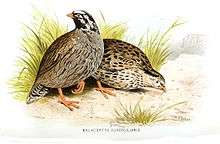
The exploitation of land and forest resources by humans along with capturing and trapping for food and sport has led to the extinction of many species in India in recent times. These species include mammals such as the Asiatic cheetah, wild zebu, Indian Javan rhinoceros, and Northern Sumatran rhinoceros.[28] While some of these large mammal species are confirmed extinct, there have been many smaller animal and plant species whose status is harder to determine. Many species have not been seen since their description. Gir forest in India has the only surviving population of Asiatic lions in the world.
Some species of birds have gone extinct in recent times, including the pink-headed duck (Rhodonessa caryophyllacea) and the Himalayan quail (Ophrysia superciliosa). A species of warbler, Acrocephalus orinus, known earlier from a single specimen collected by Allan Octavian Hume from near Rampur in Himachal Pradesh, was rediscovered after 139 years in Thailand.[29][30]
National animals
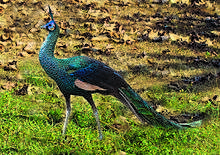
- National animal: Royal Bengal tiger
- National heritage animal of India: Elephant
- National mammal: Hanuman langur
- National aquatic animal: Ganges river dolphin[31]
- National bird: Peacock
Biosphere reserves

The Indian government has established eighteen biosphere reserves of India which protect larger areas of natural habitat and often include one or more national parks and/or preserves, along buffer zones that are open to some economic uses. Protection is granted not only to the flora and fauna of the protected region, but also to the human communities who inhabit these regions, and their ways of life.
The bio-reserves are:
- Achanakmar-Amarkantak
- Agasthyamalai
- Dibru Saikhowa
- Dihang Dibang
- Great Nicobar
- Gulf of Mannar
- Kachchh
- Khangchendzonga
- Manas
- Nanda Devi
- The Nilgiris
- Nokrek
- Pachmarhi
- Simlipal
- Sundarbans
- Cold Desert
- Seshachalam hills
- Panna

Eleven of the eighteen biosphere reserves are a part of the World Network of Biosphere Reserves, based on the UNESCO Man and the Biosphere Programme (MAB) list.[32]
Examples of Wildlife
.jpg) The Indian rhinoceros in the Kaziranga National Park. Kaziranga in the state of Assam is home to two-thirds of the one-horned rhinoceros population.
The Indian rhinoceros in the Kaziranga National Park. Kaziranga in the state of Assam is home to two-thirds of the one-horned rhinoceros population.
_at_Nagarahole_wildlife_sanctuary.jpg)
 Yak (Bos grunniens and Bos mutus)
Yak (Bos grunniens and Bos mutus)
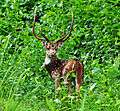
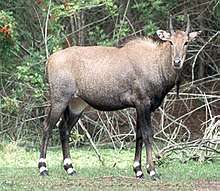 Nilgai (Boselaphus tragocamelus)
Nilgai (Boselaphus tragocamelus)_in_Ranthambore_National_Park.jpg) Chinkara (Indian gazelle)
Chinkara (Indian gazelle)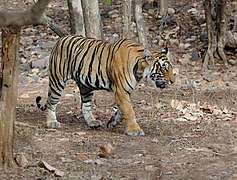 Royal Bengal tiger
Royal Bengal tiger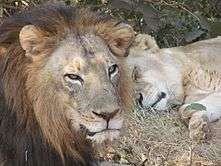 A couple of Asiatic lions at Gir Forest National Park
A couple of Asiatic lions at Gir Forest National Park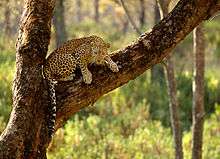 Indian leopard in Karnataka. Found across the Indian subcontinent, poaching for its skin is a threat to it.
Indian leopard in Karnataka. Found across the Indian subcontinent, poaching for its skin is a threat to it.
- Striped hyena (Hyaena hyaena)
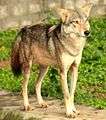

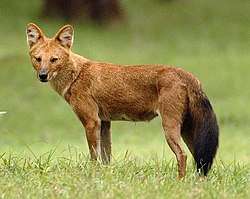 Indian wild dog (dhole)
Indian wild dog (dhole)_at_Desert_NP_(cropped).jpg)


- Hanuman langur with a newborn. At least seven species of grey langurs are found in India, out of which five are endemic.
 The Gee's golden langur, one of the world's rarest monkeys, typifies the precarious survival of much of India's megafauna
The Gee's golden langur, one of the world's rarest monkeys, typifies the precarious survival of much of India's megafauna

.jpg)




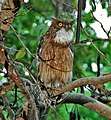
.jpg)
_from_Bahour_lake_IMG_4171_a.jpg)

.jpg)
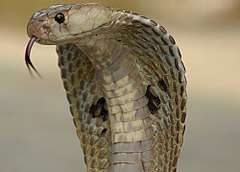
.jpg)
 Draco dussumieri (southern flying lizard)
Draco dussumieri (southern flying lizard)
_from_Vagamon%2C_Kerala_(13).jpg)


.jpg)
See also
- Birding in Chennai
- Birdwatchers' Field Club of Bangalore
- Endemic birds of the Andaman and Nicobar Islands
- India Nature Watch
- Indian Council of Forestry Research and Education
- List of birds of India
- List of mammals of India
- List of reptiles of South Asia
- Van Vigyan Kendra (VVK)
- Wildlife of Iran
- Wildlife of South Asia
- Wildlife Population of India
References
- ↑ Encyclopedia of World Geography By Peter Haggett
- ↑ "7 Rare and Exotic Wildlife Species that can be found in India".
- ↑ "Animals in Indian Sub-Continent".
- ↑ "Stephen et al., 2015 - Indian Biodiversity: Past, Present and Future, International Journal of Environment and Natural Sciences, Vol.7, 13-28" (PDF). Retrieved 2018-02-20.
- ↑ "CEPF.net - The Biodiversity Hotspots". www.cepf.net. Retrieved 2017-03-05.
- ↑ South India By Sarina Singh, Stuart Butler, Virginia Jealous, Amy Karafin, Simon Richmond, Rafael Wlodarski
- ↑ Biodiversity and its conservation in India By Sharad Singh Negi
- ↑ Explorations in Applied Geography By Dutt Misra & Chatterjee (eds.), L. R. Singh, Ashok K. Dutt, H. N. Misra, Meera Chatterjee
- 1 2 Indira Gandhi Conservation Monitoring Centre (IGCMC), New Delhi and the United Nations Environmental Programme (UNEP), World Conservation Monitoring Centre, Cambridge, UK. 2001. Biodiversity profile for India.
- ↑ K. Praveen Karach. (2006). Out-of-India Gondwanan origin of some tropical Asian biota
- 1 2 Tritsch, M.E. 2001. Wildlife of India Harper Collins, London. 192 pages. ISBN 0-00-711062-6
- ↑ Groombridge, B. (ed). 1993. The 1994 IUCN Red List of Threatened Animals. IUCN, England, Switzerland and Cambridge, UK. lvi + 286 pp.
- ↑ Luo, S.-J.; Kim, J.-H.; Johnson, W. E.; van der Walt, J.; Martenson, J.; Yuhki, N.; Miquelle, D. G.; Uphyrkina, O.; Goodrich, J. M.; Quigley, H. B.; Tilson, R.; Brady, G.; Martelli, P.; Subramaniam, V.; McDougal, C.; Hean, S.; Huang, S.-Q.; Pan, W.; Karanth, U. K.; Sunquist, M.; Smith, J. L. D., O'Brien, S. J. (2004). "Phylogeography and genetic ancestry of Panthera tigris". PLoS Biology. 2 (12): e442. doi:10.1371/journal.pbio.0020442. PMC 534810. PMID 15583716.
- ↑ Jhala, Y. V., Qureshi, Q., Sinha, P. R. (Eds.) (2011). Status of tigers, co-predators and prey in India, 2010. National Tiger Conservation Authority, Govt. of India, New Delhi, and Wildlife Institute of India, Dehradun. TR 2011/003 pp-302
- ↑ Pocock, R. I. (1939). "Panthera leo". The Fauna of British India, including Ceylon and Burma. Mammalia. – Volume 1. London: Taylor and Francis Ltd. pp. 212–222.
- ↑ Botanical Survey of India. 1983. Flora and Vegetation of India — An Outline. Botanical Survey of India, Howrah. 24 pp.
- ↑ Valmik Thapar, Land of the Tiger: A Natural History of the Indian Subcontinent, 1997.
- ↑ Fungi or Fungus Wikipedia Fungus
- ↑ Classification of Organisms Wikipedia Kingdom (biology)
- ↑ Fungal biodiversity: Distribution, conservation and prospecting of fungi from India
- ↑ Fungi of India 1989-2001 ;
- ↑ Krausman, PR & AT Johnson (1990) Conservation and wildlife education in India. Wild. Soc. Bull. 18:342-347
- 1 2 Singh, Mahesh Prasad; Singh, J. K.; Mohanka, Reena (2007-01-01). Forest Environment and Biodiversity. Daya Publishing House. pp. 116–118. ISBN 9788170354215.
- ↑ Project Tiger Accessed February 2007
- ↑ NDTV
- ↑ corbett-national-park.com
- ↑ Shashwat, D.C. (27 June 2007) "The Last Roar?", Dataquest Magazine, India.
- ↑ Vivek Menon (2003). A field guide to Indian mammals. Dorling Kindersley, Delhi. ISBN 0-14-302998-3.
- ↑ Threatened birds of Asia Accessed October 2006
- ↑ The Nation, 6 March 2007
- ↑ Dolphin becomes India’s national aquatic animal
- ↑ UNESCO, Man and the Biosphere (MAB) Programme list
- SPECIES CHECKLIST: Species Diversity in India; ENVIS Centre: Wildlife & Protected Areas (Secondary Database); Wildlife Institute of India (WII)
- ENVIS Centre: Wildlife & Protected Areas (Secondary Database); Wildlife Institute of India (WII)
- Free EBOOK: Special Habitats and Threatened Plants of India; Wildlife Institute of India (WII)
- ENVIS Centre on Conservation of Ecological Heritage and Sacred Sights of India; ENVIS; C.P.R. Environmental Education Centre is a Centre of Excellence of the Ministry of Environment and Forests, Government of India. Home page
- Conservation of wetlands of India – a review by S.N. PRASAD1, T.V. RAMACHANDRA2, N. AHALYA2, T. SENGUPTA1, ALOK KUMAR1, A.K. TIWARI3, V.S. VIJAYAN1 & LALITHA VIJAYAN1; 1Salim Ali Centre for Ornithology and Natural History, Coimbatore 641108, 2Centre for Ecological Sciences, Indian Institute Of Science, Bangalore 560012, 3Regional Remote Sensing Service Centre, Dehradun, Uttaranchal 248001; Tropical Ecology 43(1): 173-186, 2002 ISSN 0564-3295; © International Society for Tropical Ecology. PDF
- ;Fungal biodiversity: Distribution, conservation and prospecting of fungi from India. By: C. Manoharachary, K. Sridhar, Reena Singh, Alok Adholeya, T. S. Suryanarayanan, Seema Rawat and B. N. Johri. CURRENT SCIENCE, VOL. 89, NO. 1, 10 JULY 2005. PDF
- ;Fungi of India 1989-2001. By: Jamaluddin, M.G. Goswami and B.M. Ojha, Scientific Publishers, 2004, vii, 326 p, ISBN 8172333544.
External links
| Wikimedia Commons has media related to Wildlife of India. |
- Official website of: Government of India, Ministry of Environment & Forests
- "Legislations on Environment, Forests, and Wildlife" from the Official website of: Government of India, Ministry of Environment & Forests
- "India's Forest Conservation Legislation: Acts, Rules, Guidelines", from the official website of the Government of India, Ministry of Environment & Forests
- Wildlife Legislations, including - "The Indian Wildlife (Protection) Act" from the Official website of: Government of India, Ministry of Environment & Forests
- Eight lions, 15 tigers, and a whole lot of elephants — an Indian wildlife safari